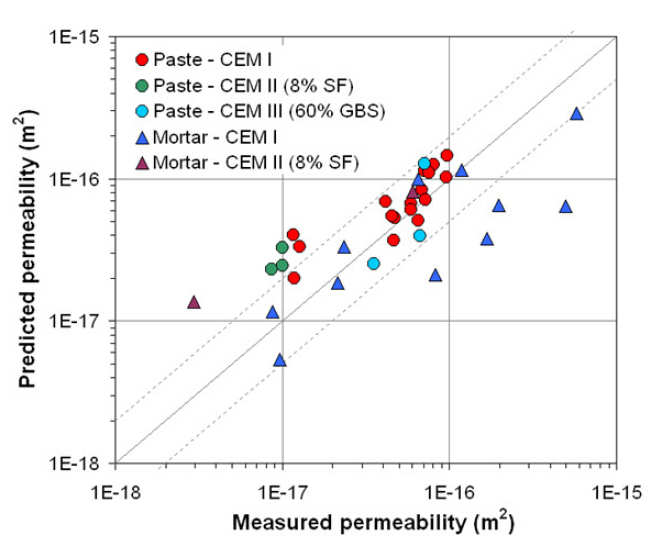Predicting permeability of cement-based materials from pore structure
H.S. Wong, R.W. Zimmerman, N.R. Buenfeld
This study concerns the use of backscattered electron (BSE) images of the microstructure as a starting point to predict the rate of mass transport in cement-based materials and ultimately, to predict the rate of deterioration and service life. The ability to estimate transport properties would also be of great value because laboratory measurements are expensive and time-consuming.
Since transport properties are essentially governed by the pore geometry, it follows that it should be possible to estimate transport properties from quantifiable attributes of the pore structure. In an earlier study [1], we showed that pore data obtained from backscattered electron images of cement-based materials are strongly correlated to transport properties and that they may be used as input to model transport. We applied the data to predict the permeability of mortars using a simple Kozeny-Carman model, but obtained errors larger than a factor of five from laboratory measured values.
A new method for estimating permeability, developed by the authors and not previously applied to cement-based materials or materials of such low permeability, is described in this study [2]. The model is entirely based on pore data obtained from BSE images, requiring only the pore areas and perimeters as input, and involves minimal computational effort.
In this method, the pore structure is idealised as a cubic lattice having pores of arbitrary size. The hydraulic conductance of each pore is calculated using the hydraulic radius approximation, and a stereological factor is applied to account for the random orientation of the image plane. A 'constriction factor' is then applied to account for variations in pore radius along the pore axis. Kirkpatrick’s effective medium equation is then used to obtain an effective pore conductance, from which the macroscopic permeability is derived.
The method was applied to 46 cement pastes and mortars having a wide range of w/c ratio, cement type, curing age and sand content. The measured oxygen permeability covered more than two orders of magnitude of data, from 3´10-18 m2 to 5.8´10-16 m2. Backscattered electron microscopy and image analysis were carried out to measure the pore structure (Figure 1) and data were used as input into the model.
Results show that about 76% of the predicted values are within a factor of ±2 from the measured values, and 98% are within a factor of ±5 (Figure 2). The average percentage error based on absolute values is 63% and 62% for paste and mortars, respectively. The predicted values lie within the 95% confidence limits of the measured values. These results show that the new method is a major improvement over the previous Kozeny-Carman model that also uses BSE image derived pore data as inputs [1].
A major difference between the two approaches is that the Kozeny-Carman model uses total porosity and specific surface area as inputs, while the current method uses data from individual pores to predict macroscopic permeability via a network model.

These results, which are obtained from a wide range of samples, show that the model can yield predictions with comparable accuracy to complex methods that involve flow simulation through the three-dimensional pore space that are much more computationally intensive and difficult to apply. The simplicity and precision of our approach lends support to the use of images of microstructure as the starting point to predict durability.
Acknowledgements: This project was supported by the EPSRC (EP/F002955/1)
References
- H.S. Wong, N.R. Buenfeld, M.K. Head (2006), Estimating transport properties of mortars using image analysis on backscattered electron images, Cem. Concr. Res., 36 [8] 1556-1566.
- H.S. Wong, R.W. Zimmerman, N.R. Buenfeld (2012), Estimating the permeability of cement-based materials using image analysis and effective medium theory, Cem. Concr. Res., 42, 476-483.


